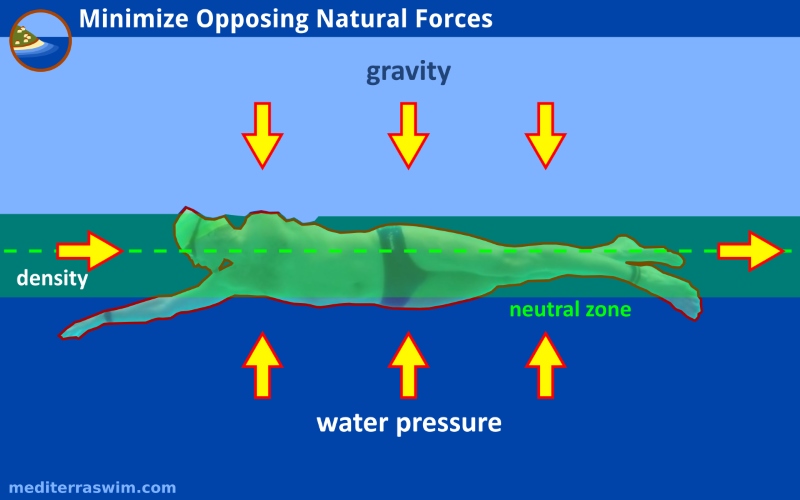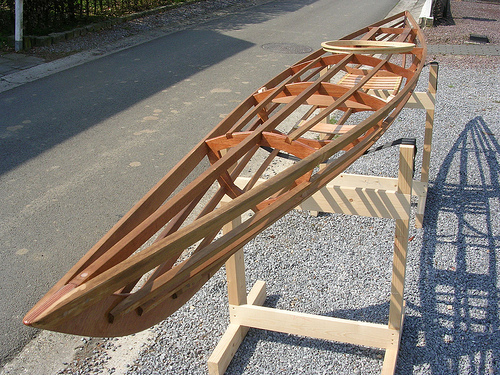How Can We Help?
Intro to Build The Frame
Build The Frame Introduction
This introduction refers to the first of our Four Essential Features of the freestyle stroke: Build The Frame.
The first skills we work on is to lengthen the body line, and establish better balance, from front-to-back and from side-to-side (lateral balance) with the support of water beneath.
Lengthen The Body Line
Like building the frame of a long, lean sea kayak, we need to lay the body out on the surface of the water and lengthen it along the spine. This lengthening of the body triggers a response inside the body to stabilize the spine, pelvis and legs, forming one long fuselage.
This lengthening you want to create is meant to put the spine into a neutral position, to stretch it out and stabilize it comfortably. Your body should feel straight and tall, but not strained to hold this position.
Balance
Balance refers to keeping the body parallel to the surface, in the ‘neutral corridor’, or the ‘neutral zone’ between gravity pushing down and water pressure pushing up. This is the corridor where you can swim along without having to waste energy fighting against those two natural forces.

The human body will rest in water like an iceberg. When at rest between gravity and water pressure, approximately 95% of your body will be submerged, give-or-take depending on your body composition. You choose which 5% of your mass gets to stick above the surface. Unfortunately, the head makes up about 10% of body mass and so if you insist on keeping it up, above the neutral zone like a good land-mammal, gravity will shove some other part of your body deeper, triggering a sinking sensation detected by your brain which raises your heart rate, and requires you to start pushing down in order to hold too much of your body mass too high. Your sense of effort will go way up. So, you will practice keeping the head down in the water, where it can fully rest on the water as if on a pillow. A body at rest in the neutral corridor, parallel to the surface, will have just a sliver of the back of the head, the back of the shoulder, and perhaps a side of the hip touching the air.
Using the drills and cues, you work on keeping your body’s frame parallel to the surface by shifting weight forward through that frame. You let the weight of the head and the weight of the arms be heavy, letting them rest fully supported by the water, rather than hold them up. You use the internal tension of your muscles, tendons and fascia to lever your long body line body like a teeter-totter board, pivoting over the buoyant lungs, to shift weight forward, making the upper half of the body feel heavier, and the lower half feel lighter. This will be especially important and appreciated by those who have sinking hips and legs.
Like a torpedo, think of your body line like a long, firm, sleek, weight (more evenly) balanced from rear to front. Think of the body traveling parallel to the surface and just below it.
Build The Frame
Let us use a couple analogies here to make the point…

First, imagine a long, straight, firm torpedo. The torpedo is very straight, very solid, and aims straight for the target with no deviations up/down, side-to-side. The force from the motor in the rear is transmitted along the torpedo frame, into the water-cutting edge in front.
This is what you want your spine, from tip of your head, the your tail, and even down the imaginary line between your ankles, to look and feel like. The tip of your head, where the spine would project if it were continued on a laser line, is the tip of your torpedo. Aim that tip underwater, down the lane in the direction you are traveling.
This means your eyes will be looking straight down at the bottom of the pool, not forward, not even a little bit.
Your shoulders and your hips will be locked together, forming a single, solid torso unit. When the torso rotates, the shoulders and hips rotate together as one unit. And, when the torso rotates, the head remains anchored, not turning. The torso turns around the stationary head.
This alignment and and this firm connection along the spine means less stress and more protection for the neck and spine. For anyone who has had neck or back problems, this is good news.

And, now imagine a long, sleek, firm wooden kayak frame. Once wrapped with a tight covering, that internal frame provides two services to the vessel:
1. The water can push up and support the entire vessel evenly.
2. The frame can receive and transmit the force the paddler creates with each stroke of the paddle.
By simply putting your body into a certain shape and then holding that shape firmly, continuously, the water can more easily support your entire body at or near the surface, and when you apply propulsive force, the body can transmit that to the water-splitting edges in front.
If the body is not fully firm, then the water presses up against the body less uniformly. The buoyancy in the upper half of the body cannot lend its buoyancy to the lower half.
If the body is not fully firm, then when you sends a wave of force into it from the stroke, the body absorbs that wave rather than transmit it to the front, where it can be put to work parting water ahead.
This frame alone may not be enough to bring the lower part of the body up to the surface and hold it there perfectly, but it will make it a lot easier, once you add the other three features and some forward motion.
Our very first drills in the freestyle lesson series are going to help you build this frame and learn how to use it to keep the body parallel to the surface (perhaps a bit longer than you could otherwise), and to transmit forces through your body more effectively.
